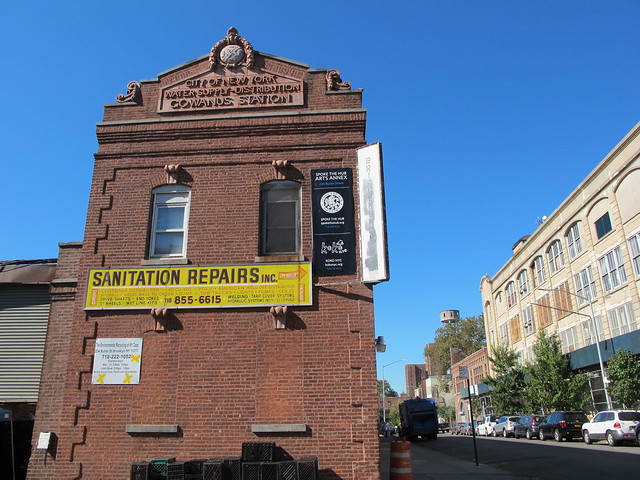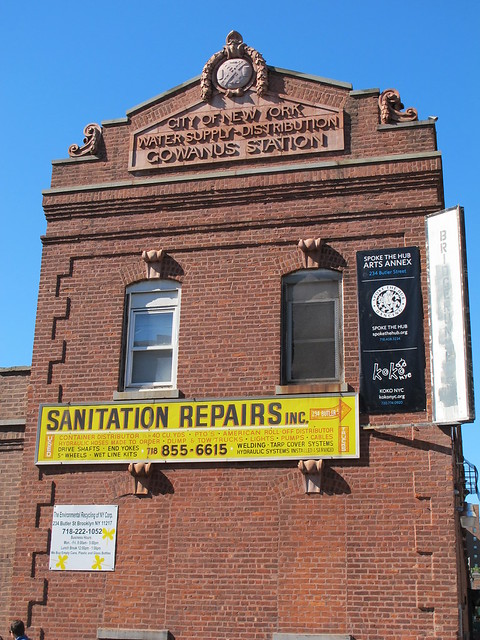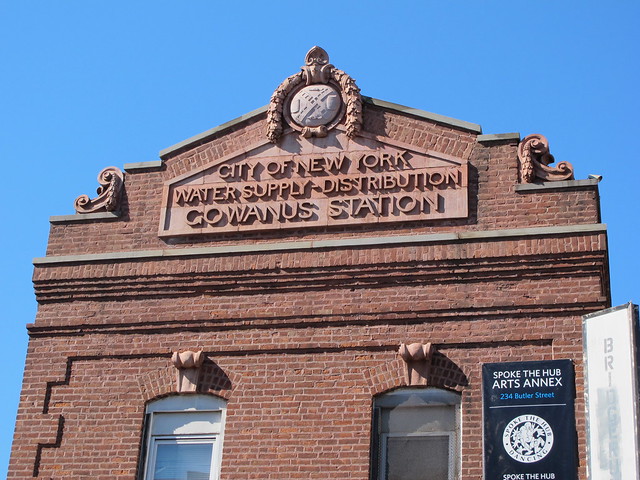The Gowanus Station Building at 234 Butler Street is at risk.
Candle Light Vigil To Save Iconic Gowanus Station will be held on April 10 from 6:30 to 7:30 at the building site, 234 Butler Street, corner of Nevins Street.
(Rain Date is April 12 at 6:30-7:30).
Community activists are continuing to speak out against a plan by the New York City Department of Environmental Protection Agency to demolish the iconic Gowanus Station building on Butler Street.
To have their voices heard, they will be holding a Candle Light Vigil at the building and are encouraging others to join.
For a bit of background on the building and how we got here:
If the New York City Department of Environmental Protection Agency has its way, the beautiful former City of New York Water Supply Distribution Gowanus Station building at 234 Butler Street at the corner of Nevins Street will be demolished as part of the current plan to build an 8 million gallon Combined Sewer Overflow tank and facility head house on the site it occupies,
This two-story beaux-arts building, built in 1913 by the Department of Water Supply, Gas and Electricity, not only reflects the larger context of Gowanus as one of the earliest and busiest industrial and manufacturing centers in this country, it is also unique for being the only building that actually bears the name of the neighborhood.
There has been much advocacy from members of the community to save the building, or at the very least, incorporate its facade into D.E.P.'s design for the C.S.O. facility.
Support came from the New York State Historic Preservation Office (SHPO), which wrote in October 2017: "Based on our review of the project details to date, it appears feasible to retain and incorporate the historic former Gowanus Station Building (234) Butler Street into the project. This building which has a prominent street presence on the corner and the very edge of the city’s preferred site, has overreaching significance on the National Register eligible Gowanus Historic District. Its demolition would adversely affect both the building and the National Register eligible Gowanus Canal Historic District. To destroy this intact, architecturally distinctive example of Brooklyn’s civic and industrial heritage would be a disservice to the Gowanus neighborhood and to the city as a whole.”
Borough President Eric Adams also noted that the entire building is valued as a local resource and has been found to be significant by SHPO as part of the National Register Gowanus Historic District. "Given the building's significance to members of the community, if additional testing determines that the building's walls are structurally sound, it would be worthwhile to consider retaining the walls using creative architectural and engineering solutions, integrated into the facility's design."
Community Board 6 acknowledged the importance of the building to the community and asked DEP to "consider an alternative design to save the historic structure."
Yet, New York City D.E.P. seems determined to take a wrecking ball to 234 Butler Street. Why wouldn't the agency attempt to take the wishes of the community into consideration, you ask? Many would say that the City has never been very transparent or trustworthy when it comes to Gowanus.
To better understand the matter regarding the Gowanus Station building and how it relates to the planned C.S.O facility, let us rewind a bit.
You may remember that in June of 2016, the US Environmental Protection Agency (EPA) finalized an agreement with the City of New York that secures the design of the larger of two combined sewage and storm water overflow (CSO) retention tanks, mandated by the Federal Agency as part of Gowanus Canal Superfund cleanup.
The agreement allows New York City to locate an 8 million gallon retention tank in New York City’s preferred location, known as the “Head-of-Canal” location. It also stipulates that the EPA can require New York City to place the tank at the EPA-suggested Thomas Greene Park location instead "if certain activities do not occur on schedule, including if New York City is not able to acquire the land at the Head-of-Canal location within approximately four years."
The City's plan relies on the taking of two privately owned sites, 234 Butler Street and 242 Nevins Street, by eminent domain. A third site, 270 Nevins Street, which currently houses a film production studio, will be seized and then leased by the City for temporary staging purposes.
An application submitted by New York City Department of Environmental Protection (DEP) and the New York City Department of Citywide Administrative Services (DCAS) for the acquisition of these three privately-owned parcels needed for the Gowanus CSO Facility is currently moving through the Uniform Land Use Review Procedure (ULURP). DEP expects the ULURP to be completed by April 2018, when the NYC Council will cast a final vote.
In the meantime, D.E.P. is designing the C.S.O. facility, which includes a huge head house (for maintenance and odor control). According to the agency's plans, that head house will be located in the footprint of the Gowanus Station building at 234 Butler Street.
Kevin Clarke, the DEP Project Coordinator, told the community that his agency had determined that it was "not technically feasible" to keep the building, nor its façade, since the excavation for the retention tank would seriously undermine the structure.
According to Clarke, the Gowanus Station is too brittle, had been altered too many times over its lifetime, and did not meet code anymore. Besides, DEP feels that saving the building would 'not be a prudent expenditure."
Instead, DEP would salvage the building's parapet and other exterior elements and display them in the publicly accessible areas of the completed C.S.O. facility.
That is not enough for those who want to keep this piece of Gowanus history.
Please join the candle light vigil and make your voice heard.











.JPG)

8 comments:
DEP are willing to save the good looking part of the building and put in a much needed overflow tank. Not sure what we are trying to save here.
I imagine the only way to have both a CSO tank and preserve the building is likely much more expensive.
I'd trade in a cleaner Gowanus for a few dated buildings any day.
... and what happened to the Kentile Floors sign? Brooklyn artifacts get no respect.
Re: the previous comment. No, DEP is not willing to save the good looking part of the building (which is the entirety of the 2-story portion). They are willing to remove a few elements for theoretical inclusion in a bland, could-be-anywhere, oversize, probably not actually required headhouse and would destroy over 95% of Gowanus Station. You and DEP are spreading the false notion that there is some stark black and white choice between the CSO tank and saving Gowanus Station. Both are certainly possible, it is not a zero sum game. DEP's problem here is that they were not at all creative or sensitive when they began planning this project, they didn't listen to community input about Gowanus Station at the first scoping session - and they never really considered the much cheaper, easier alternative of the park site (it would cost millions less for the park site because the city wouldn't have to buy out properties or use eminent domain to acquire them). Nor did DEP consider moving the headhouse further south along the canal-side site to avoid Gowanus Station. This irrational approach is being driven by a concerted political effort to keep a portion of the park from being the tank site at all costs - because of a few select constituencies that have been lobbying hard. But the part of it that makes no sense...is that the park will have to be torn up anyway as part of the cleanup because it has massive coal tar plumes under it. So, your assertion, commenter, that the only way to have the CSO tank and preserve the building is more expensive...is quite wrong. I'd trade your blithe dismissal for some hard facts, an historic building AND a CSO tank any day.
The CAG refuses to demand answers from the EPA.
If our EPA is dredging the Canal, why not have a 2 mile long retention tank below the waterway and no upland property would be needed. The EPA refuses to listen to local concerns! We should start discussing Superfund Removal Procedures instead of lighting silly candles.
The DEP has "voluntarily" set out to spent way-way-way more money on what at this point must be a sewage holding tank lined with gold. The DEP has now stated, under oath at a city council hearing that they are putting 1.2 Billion dollars towards these two sewage tanks. Together the tanks will hold 12 million gallons of sewage during rain storms. That comes to $100,000 construction cost per gallon of sewage flow. The lining of the tanks with gold can be the only explanation for this kind of expense.
The EPA does not require the DEP to build such elaborate tanks. These are essentially concrete basins which expand the underground area of the sewage collection system.
And another of the primary driver of the high costs here is the DEP's choice of placing the tank at the canal's edge, which complicates matters given the elevation of the land and the adjoining water mass.
And where is the serious city "Review" of this project and it's budget?
--certainly doesn't seam to be coming from the City Council.
Only in Brooklyn ...
$1.2 Billion of City Tax funds are to be spent to comply with the EPA's consent order. This is an unfunded mandate that will cost TWICE what the EPA will spend ($605) on the project.
Let's discuss what's needed to remove the designation and instead use the ACOE remediation funds (currently available from harbor deepening program) instead?
First of all EPA is not spending a single dime on Gowanus. National Grid and other responsible are footing the bill to clean up the bottom mess. And yes because the City's roads, bridges, subways, schools, public housing, and utilities etc ect are just in such perfect condition, by all means lets have the taxpayers fork over a little a more on the billion dollar tanks for gowanus to save this building since they are not "listening" to the community. No need for any of the that dough elsewhere.
EPA is supposed to recover funds spent but they continue to evade requests for project expenditure details. What has been expended and contracted? National Grid customers (not the company) are funding a tiny portion ($25M) of the $605M estimated cost. see: http://www.silive.com/news/index.ssf/2016/10/national_grid_proposes_rate_hi.html
We need to start discussing how to remove the Gowanus from NPL so that free federal funds (from ACOE) can be applied to environmental cleanup instead of building a wall.
Post a Comment